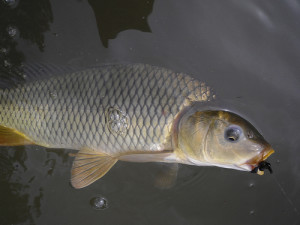Fly fishing for carp can be a killer rush—but, it can also be incredibly frustrating.
This frustration is quickly compounded if you have a wealth of experience fishing for other species, like trout or bass, because the techniques and equipment will be unfamiliar. This is exactly why you need carp flies that work.
Great carp flies will mimic the way carp eat—which can be very different from the way trout or bass feed. Having the right flies on hand is extremely important, as is using the right techniques.
Before we get into the flies, let’s look at how carp feed.
Carp Feeding Behavior
Carp will feed on a variety of prey, including leaches and baitfish, but their primary forage remains crawfish.
Larger crawfish—those in the 3-5 inch range—will of course attract the largest carp.
Now, this is not to say they will not feed on aquatic insects. In fact, I have seen carp caught on nymphs, and have even seen them rise to dry flies. If I had not seen it with my own eyes, I probably would not have believed it, but I have!
While this is not their primary behavior, it’s a good idea to match the hatch on whatever body of water you are fishing on, and bring along some insect mimicking flies just in cast.
For the most part, we will be focusing on the larger prey—specifically the crawfish.
Carp Flies That Work
In general, good carp flies are going to feature rubber legs that look like the legs of their primary prey, but this is not a hard and fast rule.
Here is a list of carp flies that have produced plenty of fish for me and those that I know in various parts of the country. They are not listed in any particular order:
- Ellis’s Bling-Cray
- Ellis’s Hook Up Nymph
- Whitlock’s Crawfish
- Cowen’s Bonefish Scampi
- Crazy Charlie
- Clouser Swimming Nymph
Those are my money patterns. This next list are patterns you should have with you just in case—they have each produced a lot of fish, just not with the same frequency as the list above:
- Woolly Bugger
- San Juan Worm
- Shaky Head Worm
- Pheasant Tail Nymph
- Stonefly Nymph
- Hare’s Ear Nymph
All told, that is 12 patterns that I take with me every time I am going to target carp—call it the Dirty Dozen!
It is not only important to have the right patterns to present, but also to present them in the right way. Let’s briefly look at a some techniques, and some gear you will need to put your hands on these fish.
Carp Fishing Techniques And Tactics
More than any one “technique” you should employ when after the golden ghost, it is important to keep one word in mind—stealth!
This is what I like to call “ninja fishing,” because carp are extremely weary, and amazingly easy to spook. Imagine targeting wild brook trout on small mountain streams because that is on par with the way you have to approach these fish.
If they see you—they’re gone.
If you wade like a rhino—they’re gone.
If you move all over the place—they’re gone.
You must stalk them, being ever vigilant to what’s going on around you. Pay attention, and you will get a chance to present your fly. It may mean making longer than normal casts, or shooting a fly like a bow and arrow from behind a tree.
Recommended Gear
Carp can grow in excess of 20 lbs., so you need gear that can handle that type of brawn.
I prefer 6 to 8 weight rods, at least 9 feet in length. Grab some floating weight forward or double taper line, and match the rod weight. 9 to 15 foot leaders are usually the way to go, with fluorocarbon being preferred.
Of course this can vary depending on your local area.
Chasing after these golden monsters can be a lot of fun! If you’ve never tried it, start out with the carp flies I’ve suggested here, and then experiment to find what works best in your waters.
See ya on the water…
